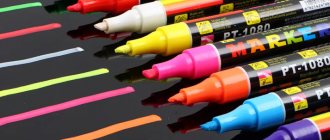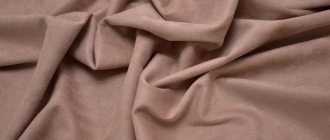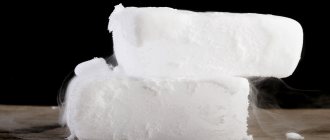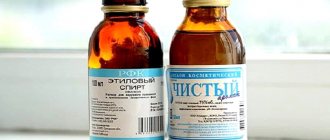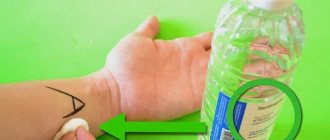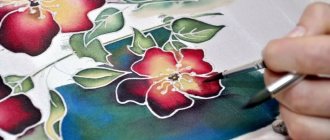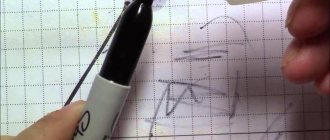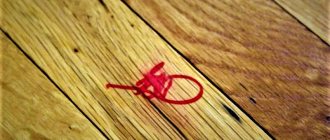During the repair process, a permanent marker is used to smoothly paste the wallpaper. It will also help in other cases when it is necessary to put a mark. But there is a possibility of getting your hands or clothes dirty. If you do not put a cap on the marker, there is a risk of staining the furniture. There are several ways to wipe off a permanent marker, the essence of which depends on the type of writing medium and the type of stained surface.
Types and uses of permanent markers
In appearance, a permanent marker is no different from a regular marker. The only difference is increased resistance to moisture, ultraviolet radiation, and high temperatures. When applied to the surface, the inscription dries instantly.
Markers are available in an assortment of colors, the most popular being white and black permanent markers.
Such markers are used for applying inscriptions and drawings to various surfaces, including metal, glass, and plastic.
Trim off the dried end
A fairly simple method, but only suitable if you know how to handle scissors carefully.
You will need nail scissors. Slowly and carefully cut off the dried tip, carefully following the shape of the applicator. It must not be violated under any circumstances. Make the applicator thin and sharp so that it is still comfortable to draw lines with, and maybe even more comfortable than before.
To understand which part has dried, hold the felt-tip pen up to the light. Those places where there is no shine are dry, since liquid does not fall on them.
Folk remedies for removing marker traces
You can wipe the marker off the table, from fabric, plastic and other surfaces using folk remedies. The most effective include the following:
- Soda solution. Pour 2 tbsp into a small amount of water. l. baking soda and apply liberally to the stain.
- Hair fixation spray. The product is sprayed onto the mark and after 5 minutes it is removed with a rag.
- Tea tree oil. A piece of woolen cloth is soaked in it and the contaminated area is treated. This tool helps to quickly remove the marker from the board.
The hardest thing to get rid of is an old stain. In this case, use a solution of lemon juice. Add 1 tbsp to a glass of water. l. liquids and wipe away marker marks.
Selecting a cleaning method
Removing marker marks is difficult. These stationery items are designed to provide long-lasting writing. That's why they are also called indelible.
You can remove the stain, but you need to keep in mind that if you do the work carelessly, you can ruin the item. Before doing this, you need to study the composition of the marker. The remedy is selected based on this information.
Let's understand the terms: marker, felt-tip pen, highlighter, liner
All marker products can be globally divided into groups according to their intended purpose - for paper and other surfaces, and according to the nature of the ink - erasable and permanent.
A felt-tip pen is a device for writing and drawing using special ink flowing from a container to a pointed, dense tip. The diameter of the body is usually about 0.8-1 cm. Felt-tip pens include markers (permanent and washable), capillary pens, liners, and text highlighters.
Markers are writing or drawing tools that have a special reservoir filled with paint. The body has a diameter of 1-2 cm. The tip can be of two types - round (bullet-shaped) and beveled (wedge-shaped). Markers are divided by purpose - permanent, for boards (board markers) and flipcharts.
Text highlighters are felt-tip pens designed to highlight parts of text. They have a beveled wedge-shaped tip, 2-5 mm thick. The ink used is bright and translucent so that the text is visible.
Liners (liners) are thin felt-tip pens for artistic drawing, calligraphy, and sketching. The lines are about 0.05-2.5 mm. As a rule, it is refilled only with black paint.
The production technology for different types of felt-tip pens is similar; only the chemical composition of the ink and the impregnation of the rod (alcohol or water) change.
If you are interested in the technological process, watch this video from the Discovery Science channel, which explains the production of markers in detail and in accessible language. Cognitive for general development.
For various tasks
The marker filler and its writing unit differ depending on the type of activity and scope of use of the tool.
For inscriptions on wood, use a tool filled with opaque mastic, which is perfectly absorbed into fibrous wood.
For permanent marking of smooth glass, plastic and metal surfaces, a permanent waterproof marker with ink filler is used. Such inscriptions can be removed with an organic solvent.
If durability is not so much important as color brightness and decorative effect, then you should turn to a chalk industrial marker. This tool is filled with liquid chalk in very bright and pure colors. Chalk marker has several features: drying time is a few minutes, resistance to wet environments, and can be washed with a damp sponge.
Plastic surgeons, dermatologists and radiologists use non-toxic medical markers to mark a patient's skin. Traces of such a tool are harmless and are washed off with water.
Marking difficult materials: oily, rusty, rough and constantly wet surfaces is a challenge for solid paint filler. There is no rod as a separate element in such a marker. Its role is played by paint pressed into the shape of a tip. Markers of this type are called “paste markers”.
How to choose and why?
Above was a simple example with a warehouse worker and a school student. A student may find a marker useful for more than just disc signatures. Let's assume that there is a large plastic ruler whose numbers on the scale have been erased. With a thin marker you can easily restore the inscription. It is better not to use it for wall newspapers, as there is no point in it. Let the permanent marker be used in necessary cases where neither a pen, nor a pencil, nor a felt-tip pen will help.
You can sign jars with blanks, boxes made of any material, tools and wrenches, and various parts with a permanent marker. It will be convenient for gardeners and gardeners to sign glasses with seedlings. And you don’t have to be afraid that the letters will be erased due to exposure to water or a solution with fertilizers. As stated at the very beginning of the article: permanent means durability and reliability.
For example, the Edding permanent marker has a wide range. The mentioned company manufactures various types of them for their respective purposes. Each marker has its own model, which is written on the body. For example, Edding-750, white. They use inscriptions instead of light paint, which is very convenient.
What does "permanent" mean?
Let's analyze what this term means. In French and Latin, the word is almost similar and has the same translation: “permanent”, “indelible”. Such a marker is used in various areas where it is necessary to apply an inscription, drawing, sign or sign.
It differs from a simple thick felt-tip pen in that the inscription will not be erased unless you put some effort into it. Currently, it is popular to apply temporary tattoos and draw eyebrows with a permanent marker. After all, with its help you can create any images, not just text. For example, a marker - permanent, white - can easily replace a thin brush with paint for applying various designs to the dark surface of any material. It is thanks to his tenacity and accuracy that he is indispensable in any field. Schoolchildren and students especially like to use it.
For various tasks
The marker filler and its writing unit differ depending on the type of activity and scope of use of the tool.
For inscriptions on wood, use a tool filled with opaque mastic, which is perfectly absorbed into fibrous wood.
For permanent marking of smooth glass, plastic and metal surfaces, a permanent waterproof marker with ink filler is used. Such inscriptions can be removed with an organic solvent.
If durability is not so much important as color brightness and decorative effect, then you should turn to a chalk industrial marker. This tool is filled with liquid chalk in very bright and pure colors. Chalk marker has several features: drying time is a few minutes, resistance to wet environments, and can be washed with a damp sponge.
Plastic surgeons, dermatologists and radiologists use non-toxic medical markers to mark a patient's skin. Traces of such a tool are harmless and are washed off with water.
Marking difficult materials: oily, rusty, rough and constantly wet surfaces is a challenge for solid paint filler. There is no rod as a separate element in such a marker. Its role is played by paint pressed into the shape of a tip. Markers of this type are called “paste markers”.
Varieties
Permanent nibs vary in shape and thickness of the writing part:
- In shape - round (bullet-shaped) and beveled (wedge-shaped).
- By thickness – thin, medium (for offices), thick (for production).
- The length of the tip, considered optimal, is 4 millimeters.
- The thickness of the permanent tip ranges from 0.6 millimeters to one and a half to two centimeters.
- The thickness of the marker line is also provided in a wide range - from 1 to 16 millimeters.
- The most popular colors for inscriptions are blue, red, green, black. Occasionally white and brown are found.
Where can I buy?
You can find such markers for sale in regular or specialized office supply stores. But, as a rule, the colors most often sold there are black, blue, red and green. They are also available as a set. If you need white or brown, you will most likely have to order it. If the store does not bring goods to order, then the corresponding online stores will help. In the Moscow region, permanent markers of different colors and thicknesses are often sold in commuter trains or Rospechat kiosks.
How to wash clothes from clothes at home?
The marker can penetrate into deep layers of materials, making it difficult to remove. You can try soaking the item in bleach, but this method is only suitable for light-colored, non-sensitive fabrics. It should not be used for delicate materials such as satin. In this case, it is better to make a mixture of vinegar, milk and borax, which is applied to the stain for 10 minutes. Thick fabric can be cleaned with alcohol or acetone . This is an effective method for natural or artificial leather. It can be used for leather shoes, but it is not suitable for suede - here it is better not to risk it and take the item to the dry cleaner. Be sure to wipe the treatment area with a damp cloth and remove any traces of the product so that it does not corrode the material. Be careful with seams - they tend to absorb color. Do not rub the product in.
How to remove permanent marker from clothes
There is a proven method for how to wash a marker when ink from a permanent felt-tip pen gets on your clothes. In this case, all kinds of stain removers or bleaches will help to remove the stain. For white fabrics you can buy any product. For colored clothes, you need to read the label to see if the bleach is suitable for it in order to remove ink stains.
How to remove alcohol marker from fabric or knitwear
If bleach is used for cleaning, the sequence of actions is as follows:
- dilute the required portion of the substance in water;
- lower the soiled piece of cloth into the solution;
- When the stain disappears, take it out and wash the clothes.
There are the following ways to effectively wipe off a marker:
- For cotton fabrics, citric acid is suitable. You need to pour some of the juice from the squeezed lemon onto the stain and set the item aside for up to 15 minutes. Then pour the remaining juice onto the stain and wipe the mark with a soft sponge until the stain disappears. Then you need to wash off the remaining traces.
- Harsher methods are suitable for cleaning dense fabrics. Ink should be wiped off with cotton wool soaked in alcohol. If there is no pure alcohol in the house, then you need to soak a cotton ball in acetone and clean the stain until it disappears.
- Satin fabrics are cleaned with a mixture of borax, vinegar, milk and lemon juice. The first three substances take 1 tbsp. l., and lemon juice - 1 tsp. The ink trace is smeared with the solution and left for 15 minutes. After this, the mixture is washed off with a soft sponge soaked in water.
- Delicate fabrics are cleaned with a solution of lemon juice in water. The method of using the product is the same as for cotton products.
When your child has drawn patterns on the carpet with a felt-tip pen, hairspray will help. Wet the ink trail with a spray bottle and wait until the fabric is clean. Then wipe the piece of carpet with a damp cloth and dry it with a towel.
How to remove marker or felt-tip pen from leather and suede
There are two methods for removing marker from leather clothing or shoes. To do this, you need to stock up on alcohol and hairspray to fix your hair. The sequence of actions with alcohol is as follows:
- take an alcoholic drink with a strength of at least 50 degrees or pure alcohol;
- soak a rag in it;
- rub the stained piece of clothing until the stain fades;
- wash off the cleaning area with a sponge soaked in water.
Hairspray is used as follows:
- spray liberally onto a rag with a spray bottle;
- wipe the traces of ink with it;
- wash off the remaining varnish with a damp sponge;
- smear the leather product with a conditioner intended for leather care.
The same methods are suitable for leatherette products.
Removing permanent marker from suede is not as difficult as it seems. Ink on suede does not penetrate deeply because the hairiness interferes with it. The main thing is that you need to take action immediately after the stain appears. You will need a cotton pad, pure alcohol, a manicure file, paper napkins, a dry towel and a suede cleaning brush. Step-by-step instruction:
- Moisten a cotton pad with alcohol.
- To get rid of excess liquid, blot the tampon with a napkin.
- Wipe the stain with cotton wool. After each wipe, blot the cotton wool with a napkin. Repeat step 3 until the mark becomes invisible.
- If you cannot clean the suede with one cotton swab, repeat the process again.
- After cleaning the fabric, dry it with a towel.
- In cases where alcohol has no effect (with deeper ink penetration), you can use a file. It is necessary to cut off the soiled layer of matter. You should act carefully so as not to cut off excess.
- Rub the suede with a dry towel to polish it. Raise the pile with a special brush for suede.
Instead of alcohol, if it is not available, you can use hairspray to fix your hair.
Why are anonymizers needed?
In fact, the reasons for using such programs or resources can be completely different. Here are the most common:
- You work in an office, and your boss has banned you from using social networks and other entertainment portals. As a result, such sites are inaccessible to you (blocked). Of course, your boss is completely right, but if you think that you are doing quality work and you have time for social networks, then there is a way out - find the Chameleon anonymizer, open any blocked resource and kill time.
- Another reason is that you want to watch a movie on some portal, but a message appears warning that playing this video is prohibited in your region. To solve the problem, run an anonymizer or use a proxy server.
And these are not all the reasons. For example, if you change your IP address frequently, the chances of a successful hacker attack on your computer are significantly reduced.
What is a permanent marker
The revolution in writing devices, from the simplest pencils and brushes to permanent markers, is incredible. The main property of the item is the stability of the ink for working in almost any conditions (“permanent” translated from English as “stable”). The marker is a “universal soldier”: it does not leak, does not freeze, and does not require constant refilling. This miracle product applies lines not only to dry, but also to wet surfaces: they will not spread, but will be absorbed. In addition, the marker is durable: it lasts for several months.
Production technology
A permanent permanent marker is made from plastic or metal and comes in round or polygonal shapes. Be sure to use durable materials - foam, felt, plastic, nylon. The tip should not be soft, but hard and sharp; it should not become “fragmented.” A permanent felt-tip pen has the following operating principle: the writing unit is made in the form of a fibrous rod inserted into the body. The rod is impregnated with a special dye - alcohol ink. When pressed, the rod begins to spring back and fill with paint.
Marker in the traditional sense
Since its invention, the marker has undergone significant changes both in composition and in its characteristics. Markers are divided into non-permanent and permanent, that is, erasable and not. The first to appear were non-permanent markers, known as felt-tip pens. A writing and drawing implement consists of a plastic body, a vented or non-vented cap, a fibrous porous rod impregnated with dye, which ends in an oval or wedge-shaped tip. High-quality markers are environmentally friendly, they are based on water, and they retain their properties for a long time. Some types of markers are disposable, and some can be refilled after you use the paint.
The marker was invented in the middle of the last century in Japan. The first models were banned from production shortly after release due to the high lead content in the composition.
Creatures
sections used on overhead projectors, transparent foil, plastic and glass; — markers for flipcharts and whiteboards that can be wiped off with a dry sponge or napkin.
What does it consist of?
An industrial marker consists of a refill, a filler, a body and a protective cap. Depending on the task assigned to a certain type of tool, each element can be made of different materials.
The rod, which acts as a writing unit, is made of a porous material that can absorb and conduct moisture, which in this case is ink.
The rod can be made:
- oval shaped;
- round - bullet-shaped;
- in a wedge-shaped, beveled version;
- in a special horseshoe shape for painting wires.
The length of the writing unit is usually 4 mm. Sometimes a metal ball is used as a core, as in a regular ballpoint pen.
The filler for an industrial marker can be:
- water ink;
- benzene ink;
- liquid or solid paint.
Fillers are divided according to their durability into permanent and non-permanent. If the inscription needs to be preserved for a long time, then it is worth using a permanent marker. If necessary, traces of its use can be washed off with alcohol or a plastic eraser.
What to do if the felt-tip pen has dried out?
First you need to determine what base the dry felt-tip pen is on. You can find out about this on the packaging, but since packages are often lost, you can tell by the smell. If the rod has an alcohol scent, then it is alcohol-based; if not, then it is most likely water-based.
The first method to restore a felt-tip pen if it has dried out is only suitable for water-based felt-tip pens. Dip the felt-tip pen in water, it will be faster in warm water, and hold it there for at least five minutes. Some ink may leak. Then leave it to dry on a cloth you don’t mind. It may take a day for him to start writing, or maybe a little less, you can check over time. You can also use vinegar instead of water. Place a few drops on the rod, let it soak and also dry.
For alcohol markers and permanent markers, the following method is suitable:
Remove the plug that is on the end side of the case; if it cannot be removed, then pick it up with something sharp and it should give way. Place a few drops of alcohol (cologne will also work) into the ink reservoir. You can also use a method similar to the method for water markers, but use alcohol instead of water. This method will last longer.
If in the middle of the last century the appearance of the marker became a real sensation, now it can be found at any retail outlet in a wide variety of assortments. It has become, perhaps, the office employee's favorite writing implement. Unfortunately, the culture of consumption of this product in Russia is still poorly developed. According to domestic office workers, certain types of markers are not used for their intended purpose: having bought one, many still believe that they can mark absolutely everything with it - glass, fabric, and thermal fax paper.
The main producers of markers are Germans. Together with the Japanese, they occupy the top line in the price segment. For 8 years now, markers have been produced in Russia - Saratov STAMM and St. Petersburg SOYUZ. Together with manufacturers from Eastern Europe - the Czech Republic and Hungary - Russia shares the golden mean in the price segment of markers. Markers made in Southeast Asian countries - Thailand, South Korea and China - traditionally occupy the lower price segment.
Price
The cost of permanent markers ranges from approximately 80 to 600 rubles. The price depends on the brand, thickness, quality and purpose. It makes no sense for a student to buy an expensive copy for drawing. The simplest and thinnest marker is enough. On the contrary, when you need to apply large inscriptions so that they can be seen from afar or quickly found, you will have to fork out money and purchase the thickest, highest quality and, of course, expensive marker.
The development of technology in the chemical industry invariably leads to the emergence of new products in various industries. Office production was no exception. Relatively recently, the concept of a permanent marker has come into use. What is it, what are its distinctive features or properties, how to choose the right one - let’s try to summarize the available information.
In order to understand the marker and “what it is eaten with,” it is quite reasonable to consider all representatives of this class. So, what are markers as such? A marker, based on the very meaning of the word, is a device for marking or marking. Many do not find any fundamental difference in them from all known felt-tip pens. This is probably true. The only difference is that markers are not so varied in color (debatable), they allow you to write on different surfaces, they have an increased line thickness and are not used for drawing (children fundamentally disagree with the last statement).
Modern industry is ready to offer the consumer several types of these colored “tags”:
- text (intended for making notes on paper);
- varnish;
- permanent (water and alcohol based);
- remover markers (allow you to adjust inscriptions and marks);
- erasable (chalk and markers for plastic boards);
- markers for decorative works (liquid appliqués, creating three-dimensional designs on fabric, for example).
The number of types and possibilities of application is surprising. In this regard, the question arises: permanent marker - what is it? Let's figure it out. As can be learned from most sources, a permanent marker is a writing utensil that allows you to make indelible inscriptions on any surface. At the same time, the line that the marker applies does not spread (neither on paper, nor on wood, nor on metal), the paint is resistant to sunlight, high temperatures, and mechanical stress. The thickness of the tip can vary within a fairly wide range (from 0.6 mm to 1.5 - 2 cm). As you can see, the choice of permanent markers is quite wide, and everyone can find the most suitable one for their needs.
In conclusion, I would like to raise the question - how to erase this highly stable mark from the surface?
- The first way is to buy a special product at the same time as purchasing a marker, which will allow you to effortlessly remove all traces of the former presence of a paint mark and will not destroy the surface.
- If you don’t have anything more suitable at hand, and the surface from which you want to erase traces of the marker is sufficiently resistant to mechanical stress, you can use a mixture of baking soda and toothpaste (gel paste is useless, use regular one).
- Some automotive degreasers cope with this task quite successfully.
- You can try alcohol or nail polish remover.
- Sometimes you can use hairspray (not tested in my own experience). The varnish is sprayed onto the stain, after which it is washed off with cold water.
0
Sometimes people in conversation or on the Internet come across words or expressions whose meaning is not always clear to them.
It would seem such a simple definition, but you don’t understand its meaning at all.. I highly recommend adding us to your bookmarks so that you can find answers to your questions in time. Today it’s time to talk about a definition that is quite tricky for some, it’s a permanent marker
, which means you can read it a little later.
However, before I continue, I would like to advise you to read a couple more popular news on random topics. For example, what does Compensation mean? This expression consists of two words, the first comes from the Latin word “ permanens
”, which can be translated as “permanent”, and the second from the English term “
marker
” - “one who is oflomic”, the trace of which is almost impossible to erase with
this simple “device” » You can apply uniform and non-spreading lines.
These markers are usually divided into two types: alcohol-based;
Water based.
Water-based ink adheres perfectly to paper without smudging into greasy blots. As for alcohol-based ink, text or an image written with this felt-tip pen can be easily removed with a solvent, except for paper, of course. Such inks have excellent water resistance, which is their undeniable advantage, although in some situations this can pose a problem. This type of markers
They are practically not used for drawing images and sketches, since they have a fairly broad base. As a rule, they are used when it is necessary to emphasize the desired text. Permanent markers are good because after drawing a line or line, they will not spread across the paper, since they dry almost instantly. Many people used to use similar markers to write on CDs or DVDs, although this is no longer so important. Because few people use these information storage devices now.
The advantages of a permanent marker include the fact that you can keep it without a cap for several days or even weeks in a row, and the ink in it will not dry out.
Regular markers are the same felt-tip pens intended for professional use. Unfortunately, the inscription created using them takes a very long time to dry, and as a result begins to spread.
After reading this article, you will now know what Permanent Marker means.
, and how it differs from the usual
The modern stationery market offers a huge range of markers of various types and purposes. Today there are such types as: varnish, washable, permanent, graphic markers and others. This article discusses what a permanent marker is, where and how it is used.
What tools cannot be used to remove a marker?
In order not to damage your clothes, you should follow certain conditions for handling fabrics in the event of a mark from a felt-tip pen. Chemicals may not erase, but rather fix the stain. Damage to the material is possible if it contains aggressive substances. Solvents should only be used in extreme cases when other methods have proven ineffective. It is not recommended to use dry powders. Their use may cause the fabric to fade. To prevent the stain from spreading, rub gently, without going beyond its boundaries. You need to start removing marks from the wrong side and wash in cold water.
People, trying to erase traces of a marker, begin to try any means. Aggressive methods are used to combat color stains, which ultimately damage the clothes. Before cleaning, you need to find out what type of felt-tip pen caused the contamination. Based on this, you can choose a safe method for removing the stain. If you cannot determine the composition, you should start cleansing with the most gentle means - toothpaste, alcohol, dishwashing liquid, soap. If there is no effect, you can resort to other methods.
The article has been verified by the editors
Paint and varnish option
The most terrible type of coloring pencils in the context of removing stains are acrylic markers. They appeared on the market not so long ago and have already won the love of creative people who paint various things by hand.
Acrylic marker marks are very difficult to erase. To do this, use various solvents, varnish dissolving agents, gasoline, turpentine, and the like.
- Take the stained item and soak it in cold water for 5-7 minutes. The fabric should be thoroughly wet.
- Squeeze a little and place on a flat surface.
- Prepare a remedy from equal parts of vinegar and ammonia. Add a pinch of salt there.
- Soak a swab in the mixture and work the stain from the edges to the center.
- Change the cotton wool as often as needed when it gets dirty.
- Once the stain has disappeared, wash as usual.
Other Applications
No wonder, but this happens! You can use a permanent marker to paint shoes, furniture, and tiles. All that remains is to take the desired color and choose the thickness. When creating decorations or painting on glass, it will become indispensable. For example, a permanent white marker is great for drawing snowflakes on glass. Suitable for decorating holiday glasses. Sometimes you can confuse what is written or drawn with: paint, putty or a marker? After all, the benefit of a permanent marker is not only water resistance, but also extreme accuracy. Therefore, it is used in completely different areas: in schools and universities, in warehouses and factories, in creative workshops. For example, you can beautifully paint a compact disc.

